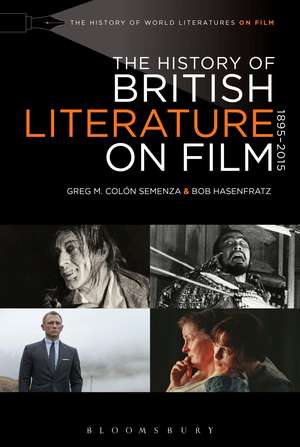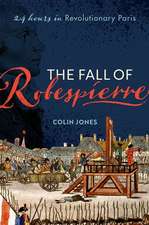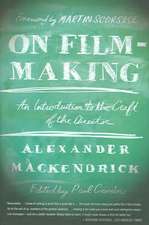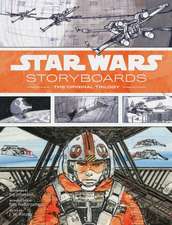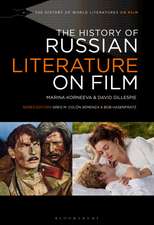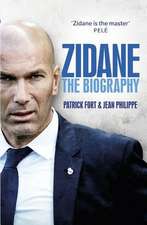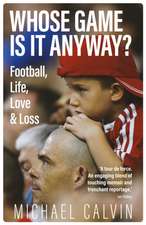The History of British Literature on Film, 1895-2015: The History of World Literatures on Film
Autor Professor Greg M. Colón Semenza, Bob Hasenfratzen Limba Engleză Paperback – 25 ian 2017
| Toate formatele și edițiile | Preț | Express |
|---|---|---|
| Paperback (1) | 192.99 lei 6-8 săpt. | |
| Bloomsbury Publishing – 25 ian 2017 | 192.99 lei 6-8 săpt. | |
| Hardback (1) | 822.74 lei 6-8 săpt. | |
| Bloomsbury Publishing – 15 iul 2015 | 822.74 lei 6-8 săpt. |
Preț: 192.99 lei
Preț vechi: 334.52 lei
-42% Nou
Puncte Express: 289
Preț estimativ în valută:
36.94€ • 38.42$ • 30.95£
36.94€ • 38.42$ • 30.95£
Carte tipărită la comandă
Livrare economică 13-27 martie
Preluare comenzi: 021 569.72.76
Specificații
ISBN-13: 9781501329852
ISBN-10: 1501329855
Pagini: 488
Ilustrații: 80 bw illus
Dimensiuni: 152 x 229 x 30 mm
Greutate: 0.68 kg
Ediția:NIPPOD
Editura: Bloomsbury Publishing
Colecția Bloomsbury Academic
Seria The History of World Literatures on Film
Locul publicării:New York, United States
ISBN-10: 1501329855
Pagini: 488
Ilustrații: 80 bw illus
Dimensiuni: 152 x 229 x 30 mm
Greutate: 0.68 kg
Ediția:NIPPOD
Editura: Bloomsbury Publishing
Colecția Bloomsbury Academic
Seria The History of World Literatures on Film
Locul publicării:New York, United States
Caracteristici
Shifts focus away from author-and text-and period-centered studies towards its evolution within film history
Notă biografică
Greg M. Colón Semenza is Professor of English at the University of Connecticut, USA. His books include How to Build a Life in the Humanities (2015), The English Renaissance in Popular Culture (2010), Graduate Study for the 21st Century: How to Build an Academic Career in the Humanities (2005; 2nd ed. 2010), Milton in Popular Culture (2006), and Sport, Politics, and Literature in the English Renaissance (2004). He has published numerous essays on film and adaptation and is now working on a book about Powell and Pressburger's wartime films. Bob Hasenfratz is Professor of English and Department Head at the University of Connecticut, USA. His books include Reading Old English (2005/11), Ancrene Wisse (2001), and Beowulf Scholarship: An Annotated Bibliography 1979-1990 (1993). He has written articles on medieval literature and culture and edits the Journal of Medieval Religious Cultures.
Cuprins
List of FiguresAcknowledgmentsIntroduction 1. Attractions, Tricks, and Fairy-Tales: Visual and Theatrical Culture in the Brit-Lit Film, 1896-1907 2. "Crude, Vicious, and Lascivious Entertainments:" The Rise of the Brit-Lit Feature Film, 1907-19203. Inter-Nationalizing the Brit-Lit Film: Hollywood and the World Film Market, 1920-1927 4. Sound, Studios, and Censorship: The Brit-Lit Film, 1927-1939 5. The Empire Strikes Back: Britain's Reclamation of Brit-Lit, 1939-1957 6. Traditions and Revolutions: The Brit-Lit Film, 1957-1979 7. The Brit-Lit Film after Film: 1979-2015 Notes BibliographyIndex
Recenzii
This rich analysis will appeal to Anglophile literature and film buffs alike.
As adaptation studies proliferate and grow more rigorous into the twenty-first century, what has been lacking is the broad cultural and historical range that this fine book maps, providing a crucial perspective on the long evolution of adaptation in Britain.
Semenza and Hasenfratz (both, English, Univ. of Connecticut) present a comprehensive survey of the adaptation of British literature to film from the beginning of film in 1895 to the present. They look at the seeming inevitability of the marriage between British literature and movies and then consider the sustainability of the pairing over the decades. In doing this, the authors pave the way for using cinematic representations to get a better understanding of cultural history and identity. The authors also look at the impact of non-British filmmakers on these representations. In addition, the text explores four issues central to adaptation: fidelity to the original text; mutation, or how works grow and change through the adaptation process; genre, i.e., whether Brit-lit adaptations can be classified as a unique genre; and innovation, i.e., whether adapted works represent "progressive" or "conservative" modes of interpretation. Clearly and concisely written and including myriad illustrations and examples to help readers better contextualize and visualize the subject, this brilliant analysis of British literature on film is a valuable resource for both film and cultural studies. Summing Up: Essential. Lower-division undergraduates through faculty.
The book's mantra is 'history matters' and the authors' approach throughout the volume is scrupulously historical, considering adaptations not by text or author, but in relation to other adaptations of a given period, progressing from the silent period to the current day. One thing they demonstrate, beyond a shadow of a doubt, is that in adaptation studies it is time to recognize that history matters.
Semenza and Hasenfratz's book certainly delights in its "capaciousness": its 450+ dense pages consider everything from the rhetoric of early cinema advertisements in newspapers to anachronistic sound in Andrea Arnold's Wuthering Heights (2011) ... Particularly welcome are the discussions of global Shakespeare, including an extensive analysis of Svend Gade and Heinz Schall's German Hamlet (1920) and Akira Kurosawa's Japanese Macbeth, Throne of Blood (Kumonosu-jô, 1957) ... The History of British Literature on Film is positioned to become a standard work in adaptation studies' ongoing quest for self-definition, and could well function as a textbook for courses exploring Brit-Lit on the world stage.
Starting from the premise that 'history matters,' Greg M. Colón Semenza and Robert Hasenfratz embark on a survey of adaptations' changing sociocultural and political contexts across the twentieth century and since. Their core mission is to examine what the shifting industrial and commercial contexts of 'Brit-Lit' film adaptations reveal about wider trends in transatlantic relations, film-making practice and the discipline of adaptation studies itself. In fluent style they chart a vast swathe of film history and provide adaptation scholars with new ways of thinking about the long history of literature's lives on screen.
Rich, insightful and extraordinarily wide-ranging, this wonderful study of British Literature on film will be an invaluable resource. Superbly illustrated, eloquently written and truly global in scope, Semenza and Hasenfratz's book is a ground-breaking piece of work.
As adaptation studies proliferate and grow more rigorous into the twenty-first century, what has been lacking is the broad cultural and historical range that this fine book maps, providing a crucial perspective on the long evolution of adaptation in Britain.
Semenza and Hasenfratz (both, English, Univ. of Connecticut) present a comprehensive survey of the adaptation of British literature to film from the beginning of film in 1895 to the present. They look at the seeming inevitability of the marriage between British literature and movies and then consider the sustainability of the pairing over the decades. In doing this, the authors pave the way for using cinematic representations to get a better understanding of cultural history and identity. The authors also look at the impact of non-British filmmakers on these representations. In addition, the text explores four issues central to adaptation: fidelity to the original text; mutation, or how works grow and change through the adaptation process; genre, i.e., whether Brit-lit adaptations can be classified as a unique genre; and innovation, i.e., whether adapted works represent "progressive" or "conservative" modes of interpretation. Clearly and concisely written and including myriad illustrations and examples to help readers better contextualize and visualize the subject, this brilliant analysis of British literature on film is a valuable resource for both film and cultural studies. Summing Up: Essential. Lower-division undergraduates through faculty.
The book's mantra is 'history matters' and the authors' approach throughout the volume is scrupulously historical, considering adaptations not by text or author, but in relation to other adaptations of a given period, progressing from the silent period to the current day. One thing they demonstrate, beyond a shadow of a doubt, is that in adaptation studies it is time to recognize that history matters.
Semenza and Hasenfratz's book certainly delights in its "capaciousness": its 450+ dense pages consider everything from the rhetoric of early cinema advertisements in newspapers to anachronistic sound in Andrea Arnold's Wuthering Heights (2011) ... Particularly welcome are the discussions of global Shakespeare, including an extensive analysis of Svend Gade and Heinz Schall's German Hamlet (1920) and Akira Kurosawa's Japanese Macbeth, Throne of Blood (Kumonosu-jô, 1957) ... The History of British Literature on Film is positioned to become a standard work in adaptation studies' ongoing quest for self-definition, and could well function as a textbook for courses exploring Brit-Lit on the world stage.
Starting from the premise that 'history matters,' Greg M. Colón Semenza and Robert Hasenfratz embark on a survey of adaptations' changing sociocultural and political contexts across the twentieth century and since. Their core mission is to examine what the shifting industrial and commercial contexts of 'Brit-Lit' film adaptations reveal about wider trends in transatlantic relations, film-making practice and the discipline of adaptation studies itself. In fluent style they chart a vast swathe of film history and provide adaptation scholars with new ways of thinking about the long history of literature's lives on screen.
Rich, insightful and extraordinarily wide-ranging, this wonderful study of British Literature on film will be an invaluable resource. Superbly illustrated, eloquently written and truly global in scope, Semenza and Hasenfratz's book is a ground-breaking piece of work.
